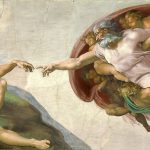Giacomo Balla, a pivotal figure in the Futurist movement, was not just a master of dynamic and kinetic art but also a man whose personal life played a crucial role in his artistic journey. His wife, Elisa Marcucci, although not as prominently known in the annals of art history, was an integral part of his life and work. This article delves into their relationship, exploring how their union influenced Balla’s creative process and the broader Futurist movement.
Giacomo Balla was born in Turin in 1871. He began his artistic education at a young age, showing an early talent that would see him become one of the forefathers of the Futurism movement. Elisa Marcucci, details of whose early life are sparse, met Balla in the late 19th century. At the time, Balla was establishing himself as an artist, exploring themes that would later categorize him as a pioneer of modern art.
Their meeting came at a time when Balla was deeply engrossed in the Divisionism technique, which involved breaking down light and color into dots and stripes. It was a method that predated and influenced the development of Pointillism. Elisa, coming into his life during such a transformative period, became the quiet cornerstone upon which Balla built his career.
Life Together
Elisa and Giacomo married, embarking on a life filled with artistic exploration and mutual support. Elisa was often seen as the stabilizing force in Balla’s life. While the details of their day-to-day life are not extensively documented, it is clear that Elisa’s presence was a significant influence on Balla’s work.
As Balla became involved with the Futurists in 1910, his work took a radical turn. The movement, founded by Filippo Tommaso Marinetti, emphasized speed, technology, youth, and violence, breaking away from the traditional and historical in art. Balla’s transition from Divisionism to Futurism was seamless, influenced perhaps by his stable home life with Elisa, which provided him a secure base from which to explore and innovate.
Contribution to Futurism
Balla’s contributions to Futurism cannot be overstated. His work “Dynamism of a Dog on a Leash” (1912) and “Abstract Speed + Sound” (1913-1914) are quintessential examples of the movement’s ethos. Elisa’s role during this period was multifaceted—she was not only a wife but also a confidante and, occasionally, a subject in his explorations of movement and light.
The home environment they created was a hub of artistic activity and a testament to their shared life. Their house in Rome became a meeting place for many young futurists. Elisa supported this, often hosting and interacting with the key figures of the movement. Her involvement, whether direct or indirect, was crucial in fostering the creative synergy that Balla’s studio was known for.
Personal Challenges and Triumphs
The couple faced numerous challenges, including the socio-political upheavals of early 20th-century Italy. The outbreak of World War I and the ensuing changes in Italian society tested their resilience both personally and professionally. However, their enduring partnership allowed them to navigate these tumultuous times.
Elisa’s unwavering support was evident during the war years when Balla’s artistic output continued unabated. This period saw Balla delving into political art, creating works that were both a reflection of and a reaction to the world around him. Elisa’s role as an emotional anchor during this time was crucial.
Later Years and Legacy
As the Futurist movement waned and Balla grew older, his and Elisa’s life together reflected a quieter, yet still creatively rich period. Balla continued to work, moving into more abstract representations and even touching on political themes. Throughout, Elisa remained by his side until her death.
The legacy of Elisa Marcucci in Giacomo Balla’s life is one of silent yet profound influence. She was not just the wife of a great artist but a fundamental part of his creative world. The stability and support she offered him were integral to his artistic output and development.
The story of Giacomo Balla and Elisa Marcucci is one of partnership and mutual influence, set against the backdrop of one of the most vibrant and tumultuous periods in art history. While Elisa may not have been an artist herself, her role in Balla’s life and work exemplifies how behind many great artists, there are often unsung influences who play critical roles in their creative ecosystems. Their life together is a reminder of the personal stories behind the grand narratives of art history.




